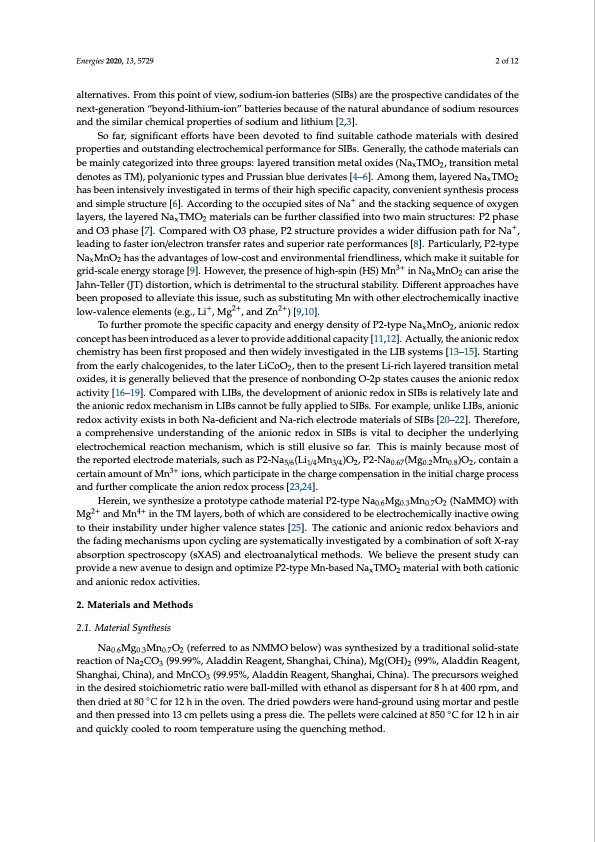
PDF Publication Title:
Text from PDF Page: 002
Energies 2020, 13, 5729 2 of 12 alternatives. From this point of view, sodium-ion batteries (SIBs) are the prospective candidates of the next-generation “beyond-lithium-ion” batteries because of the natural abundance of sodium resources and the similar chemical properties of sodium and lithium [2,3]. So far, significant efforts have been devoted to find suitable cathode materials with desired properties and outstanding electrochemical performance for SIBs. Generally, the cathode materials can be mainly categorized into three groups: layered transition metal oxides (NaxTMO2, transition metal denotes as TM), polyanionic types and Prussian blue derivates [4–6]. Among them, layered NaxTMO2 has been intensively investigated in terms of their high specific capacity, convenient synthesis process and simple structure [6]. According to the occupied sites of Na+ and the stacking sequence of oxygen layers, the layered NaxTMO2 materials can be further classified into two main structures: P2 phase and O3 phase [7]. Compared with O3 phase, P2 structure provides a wider diffusion path for Na+, leading to faster ion/electron transfer rates and superior rate performances [8]. Particularly, P2-type NaxMnO2 has the advantages of low-cost and environmental friendliness, which make it suitable for grid-scale energy storage [9]. However, the presence of high-spin (HS) Mn3+ in NaxMnO2 can arise the Jahn-Teller (JT) distortion, which is detrimental to the structural stability. Different approaches have been proposed to alleviate this issue, such as substituting Mn with other electrochemically inactive low-valence elements (e.g., Li+, Mg2+, and Zn2+) [9,10]. To further promote the specific capacity and energy density of P2-type NaxMnO2, anionic redox concept has been introduced as a lever to provide additional capacity [11,12]. Actually, the anionic redox chemistry has been first proposed and then widely investigated in the LIB systems [13–15]. Starting from the early chalcogenides, to the later LiCoO2, then to the present Li-rich layered transition metal oxides, it is generally believed that the presence of nonbonding O-2p states causes the anionic redox activity [16–19]. Compared with LIBs, the development of anionic redox in SIBs is relatively late and the anionic redox mechanism in LIBs cannot be fully applied to SIBs. For example, unlike LIBs, anionic redox activity exists in both Na-deficient and Na-rich electrode materials of SIBs [20–22]. Therefore, a comprehensive understanding of the anionic redox in SIBs is vital to decipher the underlying electrochemical reaction mechanism, which is still elusive so far. This is mainly because most of the reported electrode materials, such as P2-Na5/6(Li1/4Mn3/4)O2, P2-Na0.67(Mg0.2Mn0.8)O2, contain a certain amount of Mn3+ ions, which participate in the charge compensation in the initial charge process and further complicate the anion redox process [23,24]. Herein, we synthesize a prototype cathode material P2-type Na0.6Mg0.3Mn0.7O2 (NaMMO) with Mg2+ and Mn4+ in the TM layers, both of which are considered to be electrochemically inactive owing to their instability under higher valence states [25]. The cationic and anionic redox behaviors and the fading mechanisms upon cycling are systematically investigated by a combination of soft X-ray absorption spectroscopy (sXAS) and electroanalytical methods. We believe the present study can provide a new avenue to design and optimize P2-type Mn-based NaxTMO2 material with both cationic and anionic redox activities. 2. Materials and Methods 2.1. Material Synthesis Na0.6Mg0.3Mn0.7O2 (referred to as NMMO below) was synthesized by a traditional solid-state reaction of Na2CO3 (99.99%, Aladdin Reagent, Shanghai, China), Mg(OH)2 (99%, Aladdin Reagent, Shanghai, China), and MnCO3 (99.95%, Aladdin Reagent, Shanghai, China). The precursors weighed in the desired stoichiometric ratio were ball-milled with ethanol as dispersant for 8 h at 400 rpm, and then dried at 80 ◦C for 12 h in the oven. The dried powders were hand-ground using mortar and pestle and then pressed into 13 cm pellets using a press die. The pellets were calcined at 850 ◦C for 12 h in air and quickly cooled to room temperature using the quenching method.PDF Image | Cathode Materials for Advanced Sodium-Ion Batteries

PDF Search Title:
Cathode Materials for Advanced Sodium-Ion BatteriesOriginal File Name Searched:
charge-compensation-sodium-ion-battery.pdfDIY PDF Search: Google It | Yahoo | Bing
Salgenx Redox Flow Battery Technology: Salt water flow battery technology with low cost and great energy density that can be used for power storage and thermal storage. Let us de-risk your production using our license. Our aqueous flow battery is less cost than Tesla Megapack and available faster. Redox flow battery. No membrane needed like with Vanadium, or Bromine. Salgenx flow battery
| CONTACT TEL: 608-238-6001 Email: greg@salgenx.com | RSS | AMP |